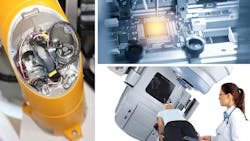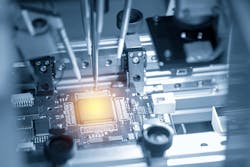Encoders and Their Applications: Keeping Control
This is the second of a two-part series. Part 1 can be found here.
Encoders are critical components in all kinds of mechanical systems. They are especially prevalent in industrial settings where large machinery performs repeatable tasks, high-precision prototyping or delicate work.
Encoders for the Electronics Industry
Encoders are critical to the production of advanced electronics, one of the fastest growing and advancing industries in the world. Rotary, angle and linear encoders are all used in one form or another in the electronics sector. Encoders of the highest accuracy and resolution are often the choice considering the small work areas and components—especially when it comes to semiconductor fabrication.
Vacuum environments are also common in electronics production. Encoders, including angle and linear, need to be built specifically for the unique ventilation, gas and temperature conditions that come with work in a vacuum.
Encoders for CNC Machining
CNC machines must maintain position in the face of heavy workpieces and spindles, multi-axis movement and high speeds. Encoders play a huge role in all of the components working together to mill, drill and bore correct parts. We also develop a full line of popular control systems and touch probes used to program CNC machines.
In 2018, we worked with Major Tool & Machine to help rebuild one of the largest machine tools in the world. Custom linear encoders were developed to accommodate the gantry mill’s staggering axes travels: the X axes alone measured 740 in. each.
Encoders for Automation
The automation industry is booming, and it couldn’t be without capable encoders. Robotic arms, like this one developed by grinding machine company Strausak, are ubiquitous in manufacturing environments. Any unmanned mechanical systems will rely on consistent and accurate motion and measuring.
Encoders are also being used to automate transportation, as with Sweden’s high-speed train, the SJ3000, which employs a custom-made, absolute MC 400 encoder from Leine Linde. It helps operate a redundant system that controls the train’s speed and braking automatically if necessary.
Encoders in the Medical Industry
Encoders are prominent in the medical industry because of the precision necessary to accurately and safely test and treat the human body—and develop new procedures in the lab. For example, you’ll find HEIDENHAIN LIC 2100 exposed linear and ECN 1123 EQN 1135 rotary encoders used in CT and MRI scanning machinery for help with precise imaging and patient safety. Radiation therapy is another application that requires precise linear and angular technology with no room for error.
Similar absolute rotary encoders are used in one of the most advanced breast cancer treatments in the world. The GammaPod by Xcision Medical Systems is billed as, “the world’s first stereotactic radiotherapy system optimized for treating breast cancer.”
Encoders in Robotics
Whether it’s an articulating arm that picks and places equipment in a manufacturing plant or more mobile, automated, guided robots, they all use encoders. By their nature, automated systems need these effective speed and positions feedback systems to function with limited human assistance. In many cases, encoders with a small profile are best suited for a robotic design, so that all the required technology can fit together in a robot that’s sized appropriately to its use.
Encoders all serve the same general purpose of measuring motion and signaling feedback, but their configurations, capabilities and applications vary widely. They have played a significant role in almost every facet of life, especially industrial and technological pursuits. And that won’t be changing any time soon.
Tom Wyatt is director of marketing and communications, HEIDENHAIN Corporation. He has more than 40 years of experience at HEIDENHAIN This article first appeared on the company’s website. For more information, click here.
This article appeared in Hydraulics & Pneumatics.



